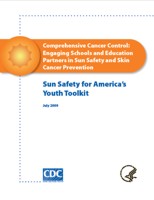Sun Safety for America's Youth Toolkit

Since 1998, the National Comprehensive Cancer Control Program (NCCCP) has provided funding and technical support to develop and implement comprehensive cancer control (CCC) plans to "reduce cancer incidence, morbidity, and mortality through prevention, early detection, treatment, rehabilitation and palliation." 1 2 Currently, the Centers for Disease Control and Prevention (CDC) Division of Cancer Prevention and Control (DCPC) "funds CCC programs in all 50 states, the District of Columbia, seven tribes and tribal organizations, and seven U.S. territories."3
Each local (state, tribe, territory, or jurisdiction) CCC program has a mandate to develop a plan that addresses a wide variety of cancer prevention and control priorities. This often includes skin cancer prevention. The Sun Safety for America's Youth Toolkit [PDF-1.2MB] is designed as a resource for local CCC programs interested in engaging schools and other education partners in sun safety efforts to reduce the incidence of skin cancer. Since a majority of sun exposure occurs during childhood and early adulthood4 and key sun protective behaviors can be established most easily at this time, addressing sun safety for young people is an important cancer control objective.
A wide variety of sun safety programs, materials, and resources are available to organizations interested in implementing sun safety efforts, many of which are described in this toolkit and the accompanying reference documents. This toolkit builds upon lessons learned from CDC's long history of sun safety and skin cancer prevention. In 2002, CDC released the Guidelines for School Programs to Prevent Skin Cancer.Guidelines for School Programs to Prevent Skin Cancer.5 The Guidelines provide resources and suggestions for schools to improve sun safety practices in seven major areas: policy, environmental change, education, family involvement, professional development, health services, and evaluation.
To foster implementation of these guidelines, DCPC, in partnership with the Division of Adolescent and School Health (DASH), made funds available to states with Coordinated School Health Programs (CSHPs) to conduct pilot skin cancer prevention activities. In 2003, through the Skin Cancer Priority Supplement to PA03004—Improving the Health, Education, and Well-Being of Young People through Coordinated School Health Programs—three states (Colorado, Michigan, and North Carolina) were awarded funds to pilot activities to address the school skin cancer guidelines. From late 2003 through early 2007, the Department of Education in each of the three funded states received funds to implement their pilot sun safety initiatives. Each state was required to develop an annual work plan that would guide their efforts to address CDC's skin cancer guidelines and develop a partnership with their state CCC program.
This toolkit draws from these efforts and is designed to provide CCC programs with resources and information that will help them to understand the burden of skin cancer in their area, assess local sun safety interest and activity, implement sun safety efforts with schools and key education partners, and evaluate their efforts.
The toolkit consists of four key steps that will help CCC programs move through a logical process for engaging and implementing sun safety efforts for young people—
- Step I: Identify and Recruit Sun Safety Partners
- Step II: Assess and Understand Sun Safety Needs and Resources in Your State/Tribe/Territory/Jurisdiction
- Step III: Plan and Implement Sun Safety Activities
- Step IV: Evaluate Sun Safety Efforts
Step I describes the numerous organizations and individuals CCC programs may want to engage in sun safety planning and implementation. These partners represent both state/tribe/territory/jurisdiction and local organizations that can play an important role in reaching schools and young people to implement and enhance effective sun safety strategies.
Step II provides recommendations for understanding the current state skin cancer burden and how to use that information to inform the development and targeting of sun safety efforts. To understand the current level of sun safety activity within the state/tribe/territory/jurisdiction, recommendations and resources are provided for conducting a sun safety program and resource inventory at the state/tribe/territory/jurisdiction level. Resources also are provided to help your CCC program understand the current legal and/or policy issues related to sun safety and how sun safety already may be integrated into existing school resources and tools.
Step III outlines a process for conducting a Strengths, Weaknesses, Opportunities and Threats (SWOT) analysis related to implementation of sun safety activities. Recommendations and resources on selection of sun safety activities are provided as well as examples of activities implemented using the CDC Guidelines for School Programs to Prevent Skin Cancer.
Step IV highlights the importance of evaluation of state/tribe/territory/jurisdiction sun safety efforts and offers some examples of how to evaluate sun safety efforts locally and at the state/tribe/territory/jurisdiction level. We also provide suggestions for modification of state surveillance systems.
Within each step, we provide examples from state sun safety efforts to help CCC programs understand how these recommendations, tools, and resources have been used by other states.
The toolkit also includes an extensive sun safety resource list, which highlights potential sun safety partners at the state/tribe/territory/jurisdiction and national levels, and other sun safety programs and materials that are available.
References
1Centers for Disease Control and Prevention (CDC). (2009). Coordinated School Health Program. Retrieved May 4, 2009.
2Centers for Disease Control and Prevention (CDC). (2009). About the National Comprehensive Cancer Control Program (NCCCP). Retrieved May 4, 2009.
3Centers for Disease Control and Prevention (CDC). (2008/2009). Comprehensive Cancer Control Program Fact Sheet. Retrieved May 4, 2009.
4Godar DE. UV doses of American children and adolescents. Photochemistry and Photobiology 2001;74(6):787–793.
5Glanz K, Saraiya M, Wechsler H. Guidelines for school programs to prevent skin cancer. MMWR 2002;51(RR–4):1–18.
Contact Us:
- Centers for Disease Control and Prevention
Division of Cancer Prevention and Control
4770 Buford Hwy NE
MS K-64
Atlanta, GA 30341 - 800-CDC-INFO
(800-232-4636)
TTY: (888) 232-6348
8am–8pm ET
Monday–Friday
Closed on Holidays - cdcinfo@cdc.gov


